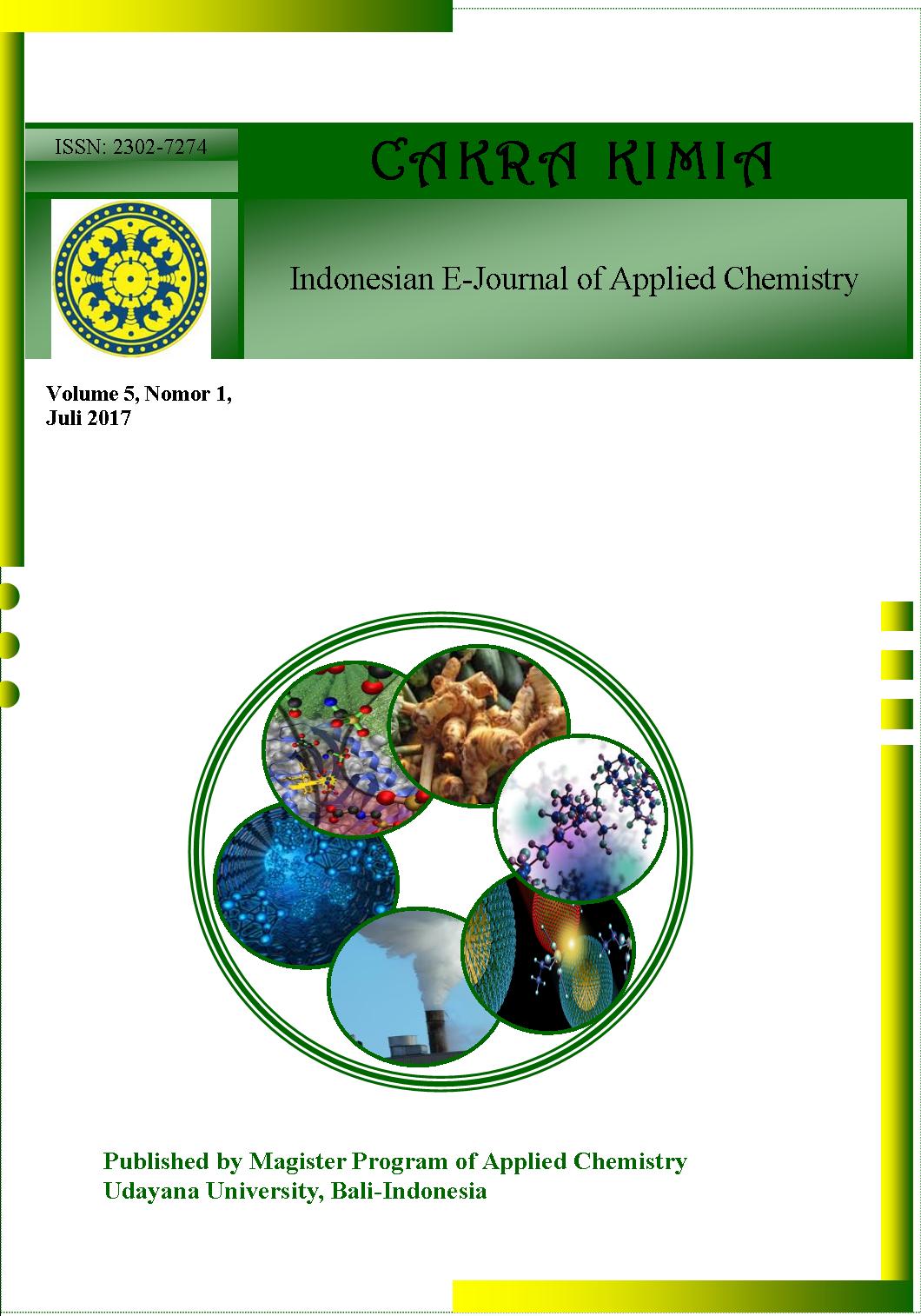OPTIMASI RASIO MOLAR DAN WAKTU REAKSI PADA PEMBUATAN BIODIESEL DARI MINYAK BIJI MALAPARI (Pongamia Pinnata L.) DENGAN KATALIS ABU SEKAM PADI TERMODIFIKASI LITIUM
Abstract
ABSTRAK: Minyak biji malapari merupakan bahan baku yang potensial untuk produksi biodiesel. Penelitian ini mempelajari optimasi rasio molar minyak:metanol dan waktu reaksi pada produksi biodiesel menggunakan minyak biji malapari dalam reaksi transesterifikasi dengan katalis abu sekam padi termodifikasi litium (Li). Variasi parameter yang digunakan untuk mendapatkan kondisi optimum yaitu rasio molar minyak:metanol dengan perbandingan 1:6; 1:9 dan 1:12 dengan waktu reaksi 150, 180, dan 210 menit menggunakan massa katalis 3% pada suhu reaksi 60-65OC. Kebasaan permukaan, situs aktif, dan morfologi permukaan katalis heterogen sebelum transesterifikasi (Li-ASP1) dan setelah transesterifikasi (Li-ASP2) dikarakterisasi. Hasil penelitian menunjukkan bahwa yield biodiesel tertinggi yaitu 88,37% diperoleh pada rasio molar minyak:metanol sebesar 1:9 dengan waktu reaksi 150 menit. Biodiesel tersebut telah memenuhi Standar Nasional Indonesia (SNI) 04-7182-2006 dengan massa jenis, viskositas, bilangan asam, bilangan iod, kadar air, dan bilangan setana berturut-turut sebesar 885,3 kg/m3; 5,75 cSt; 0,27mgKOH/g; 45,89 g I2/100g biodiesel, 0,01% dan 65,13. Nilai kebasaan permukaan katalis Li-ASP1 yaitu ±mmol.g-1 lebih besar dibandingkan dengan nilai kebasaan katalis Li-ASP2 sebesar ±mmol.g-1, situs aktif katalis Li-ASP1 sebesar 1,2103 x 1022 atom g-1 memiliki nilai yang lebih tinggi dibandingkan katalis Li-ASP2 sebesar x 1022 atom g-1. Morfologi permukaan katalis Li-ASP1 dan Li-ASP2 menunjukkan bahwa distribusi pori terlihat kurang homogen dengan bentuk partikel yang terdistribusi secara tidak merata.
ABSTRACT: Pongamia oil is a potential oil for producing biodiesel. The aim of this research is to find the optimum conditions of transesterification rection of pongamia oil using lithium-modified rice husk ashes (Li-ASP) in producing biodiesel. The molar ratio of oil:methanol (1:6; 1:9; and 1:12) and the reaction time (150; 180; and 210 minutes) were used as parameters using 3% (w/w) of the catalyst at reaction temperature of 60-65oC. Moreover, the heterogeneous catalysts before the transesterification (Li-ASP1) and after transesterification (Li-ASP2) were characterized by their surface alkalinities, active sites and surface morphologies. The results showed that the highest biodiesel yield of 88,37% was gained at molar ratio of oil:methanol of 1:9 and 150 minutes of the reaction time. The obtained biodiesel fulfills the Indonesian Nasional Standards (SNI 04-7182-2006) with values of density, viscosity, acid number, iod number, water content, and cetane number 885.3kg / m3; 5.75 cSt; 0,27mgKOH/g; 45.89 g I2/100g biodiesel; 0.01%; and 65.13, respectively. The surface alkalinity of Li-ASP1 of ±mmol.g-1which is higher than the one of Li-ASP2 of ±mmol.g-1. The active sites of Li-ASP1 of 1.2103 x 1022 atoms g-1 are higher than the ones of Li-ASP2 catalyst of 0.6414 x 1022 atoms g-1. The surface morphologies of both Li-ASP1 and Li-ASP2 indicate that non-homogenous pore distribution showing the unevenly distributed particles.
Downloads
References
[2] Sharma, Y. C., Singh, B., and Korstad, J., 2011, Latest Developments on Application of Heterogenous Basic Catalysts for an Efficient and Eco Friendly Synthesis of Biodiesel,A review, Fuel,90 (16) : 1309-1324
[3] Helwani, Z., Othman, M. R., Aziz, N., Kim, J., dan Fernando, W. J. N., 2009, Solid heterogeneous catalysts for transesterification of triglycerides with methanol,A review, Applied Catalysis AGeneral,363 (1-2) : 1-10
[4] Della, V.P., Kuhn, I., Hotza, D., 2002, Rice husk ash as an alternate source for active silica production,Materials Letters,57 (4): 818–821
[5] Dwitama, M. I., Nazib, M., Sitepu O. C., Suandi, D. A. P. dan Simpen, I N.,2016,Konversi Minyak Biji Malapari (Pongamia Pinnata L.) menjadi Biodiesel melalui Pemanfaatan Katalis Heterogen Abu Sekam Padi Termodifikasi Li,Jurnal Kimia, 10 (2) : 236-244
[6] Freedman, B., Pryde, E. H. dan Mounts, T. L., 1984. Variable Affecting the Yield of Fatty Ester from Transesterified Vegetable Oil, America Oil Chemists Society, 61(10): 1638-1643
[7] Fangrui, M., and Hanna, M. A., 1999. Biodiesel Production,A Review, Bioresource Technology, 70 (1) :1-15
[8] Affandi, R. D. N., Aruan, T. R., Taslim, Iriany., 2013. Produksi Biodiesel dari Lemak Sapi dengan Proses Transesterifikasi dengan Katalis Basa NaOH, Jurnal Teknik Kimia Universitas Sumatera Utara, 2(1) : 1-6
[9] Hardjono, 1987. Teknologi Minyak Bumi, Universitas Gajah Mada, Yogyakarta
[10] Liu, X., Piao, X., Wang, Y., Zhu, S., 2008. Transesterification with Heterogenous Catalyst in Production of Biodiesel, Energy Fuels, 22(5): 1313-1317
[11] Setyawati, E. dan Edwar, F., 2012. Teknologi Pengolahan Biodiesel dari Minyak Goreng Bekas dengan Teknik Mikrofiltrasi dan Transesterifikasi sebagai Alternatif Bahan Bakar Mesin Diesel, Jurnal Riset Industri, 6(2) : 117-127
[12] Canaki, M. dan Gerpen, J. V., 2007. Biodiesel from oils and fats with high free fatty acid,Trans America Society of Automotive Engine, 44 (11): 1429-1436
[13] Sudarmadji, S., Haryono, B., dan Suhardi., 1984. Analisa Bahan Makanan dan Pertanian, Liberty. Yogyakarta
[14] Silva, A. O. S., Souza, M. J. B., Aquino, J., Fernandez, V. J. Jr, and Araujo, A. S., 2004. Coke Removal of The HZSM-12 Zeolite With Different Silica/Alumina Ratio (Kinetic Study). Journal of the Thermal Analysis and Calorimetry 75: 482-532
[15] Standar Nasional Indonesia (SNI), 2006. Standar Biodiesel Nasional, SNI Nomor: (SNI 04-7182-2006)
[16] Thakur, D., Roberts, B., Rieke, R.D., and White, T., 1999. Fatty Methyl Ester Hydrogenation to Fatty Alcohol : Reaction inhibition by Glycerine & Monoglyceride, American Oil Chemists’ Society,76(8) : 995-1000



 Petunjuk Penulisan
Petunjuk Penulisan
